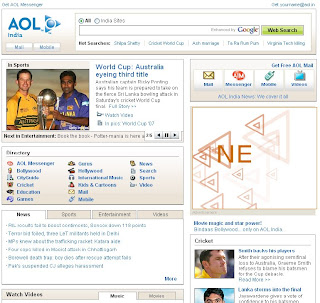Become an SEO Expert, and get the edge over others!
Have a website that needs help with SEO? Contact me with your details now for a personalized, custom review.

There are a lot of blogging talents around, that we often over look just because we are so used to think about our own blog only. Nirmal TV is an active blogger in the blogosphere here in India. His blog Life Rocks 2.0 features articles on technology, tips and tricks, blogging, tutorials and the internet ! I’ve been very impressed with his socializing skills in the Indian Arena of blogs. His blog receives on an average 20 comments on every article. Pretty cool that is!
I’m still unsure how he’s able to make others comment on his articles. However one thing that I noticed is that Nirmal himself makes it a point on other blogs too. And most of the commenters on his blog are reciprocal commenters. Which is not bad at all.
When a first time visitor comes to his blog, they’ll see a lot of comments and gets a good impression about him. And he’s likely to grab his feed. This is a great lesson to learn from Nirmal.
Nirmal is up-to-date on technology within his reach, and often strikes a point blogging about it prior to anybody else. Clever! Something to be noted about Nirmal’s articles is that he churns out lot of “Numbered lists”. Like Top 10 themes, Top 10 plugins and the like which gets dugged and stumbled upon by his readers which in turn gives him lot of traffic. Interestingly, Nirmal prefers lists with odd numbers like 7 and 9 rather than 5 and 10, which are very common on the internet.
Apart from all these stunts, Nirmal is out to grab more organic traffic online by harnessing the power of SEO. He’s approached me for a quote too. Too clever! ![]()

Photo courtesy pinklovesbrown
There’s happy news for Indian users this Independence day from Google. On the official Google blog, M T Raghunath and Gokul Nath Babu Manoharan, Software Engineers, Google has made this official announcement.
Happy 60th birthday, India! We can’t wait to celebrate, but we’re going to wait a few days for the formal unwrapping of our gift to Indian users. Check back and we’ll have news shortly.
Hmm… what could it be? Here are my guesses..
- Blogger new features update
- More features on AdSense
- Tricolour ipod for top AdSense publishers
Yeah, they are wild guesses, i know. Any clues?
I know that title would bring a frown on your face!
- It’s all over the internet Mani, what are Google images for?
Well, well i know i know! Let me explain.
In India, this is not a popular concept, but elsewhere it is. I’m talking about stock photography and royalty free images.
In the US, UK and rest of the world (excluding some countries like china,India etc) images can be used only with the photographer’s agreement.
Be it on online, editorial or any other use. There are stock photo agencies that buy the pictures from photographers and provide online stores for users to buy them.
As you buy the images, the photographers are given a percentage of the sale.
There are many affordable online stock photography agencies like istockphoto.com dreamstime.com that offer you images from as low as US $1.
But this is of no interest to us unless you want to spent a few bucks for every image on your posts. What we are interested is free royalty free images to use on every blog posts.Before we go into the sources to get free royalty free images, let’s see how this topic affect us bloggers?
Okay,so if you are in India or China or such countries where the licensed use of images, are not popular, you can manage to get free images from Google or Live image search.Fine.But what about others? Do you find images from google or ask for permission from the photographer/agency?
I think it’s fair to be asking the photographer permission to use it on your blog. you can very well reciprocate the favour by linking back to his site through a credit line.
Many a times, this results in email exchange delays and other bottle necks -hell you don’t post the article because you haven’t recieved the permission yet.
There is huge potential for stock photo agencies here - if there is a stock photo agency that will provide us bloggers with images from as low as US $1(squeeze it down even), then considering we have around 15.5 million blogs, imagine the revenue that could be generated from image use on blogs?
Darren says that he normally gets images sent to him by companies so finding images for new products is not a problem for him.I’m assuming that might be the case with Gizmodo or Techcrunch. But what about the rest of blogosphere?
Well, luckily we have a few options here -
1 - Stock Exchange.
These guys offer free royalty free images for any use. They have a pretty impressive collection of images as well. Good enough for a amateurs but not professionals.They have many smudged and brushed images also, so you may want to keep away from them but select the best ones.
They don’t want you to link back for credit or anything of that sort but from the number of backlinks they’ve got it’s clear that anyone who uses their image will link back to them.
2 - Morgue file.
The morguefile contains photographs freely contributed by many artists to be used in creative projects by visitors to the site. To acknowledge the artist’s accomplishments, we ask that you credit the photographer when possible. They have an impressive collection of images too.
3 - Indexstock
These guys have an impressive collection of images across many categories. they may not be hi-reosultion ones but fit enough to use on blogs.They are one of my personal favourites.
4 - Free large photos
This is a free images site that provides great collection of places and people photography. You have to link them back in order to use the image in your blog.
So, you have all these resources where from you can collect images of good quality for blogging purpose.The advantage you have over using Google images is that you know exactly whether the photographer/website need be credited or not and that you get good quality images.
And it is a good habit to credit the site where from you have used the image so that they know that you appreciate it. Also, asking the photographer as to whether you can use the image on your blog is also a good idea, and when it get’s frustrating you have all these free resources to try.
Images courtesy
One more reason to prove why Search Engine Optimization, is a much studied discipline(thanks to bloggers) in India, and why there are many SEO educated webmasters - I find anyone who is approaching me for links, well informed about the need for back links, PR, Google SERPs etc. This is really fantastic! Well, Here are the Quick links of all the new bloggers who have linked to Daily Dose with the anchor text - Mani SEO Services india, the last week.
- Rahul Prabhakar - when the muse strikes
- SEO Kolkata blog
- Technorati Fav Exchange links - Light within, Technix
You may link to daily dose with the anchor text - “SEO Services India” or “Mani - SEO Services India” from your blog, make sure that the link is not a javascript enabled pulldown menu but a simple HTML ahref link.The link will be reciprocated the very next week.
Just out of sheer curiosity - just have a look at the top searched queries on Google India, this March. This is according to Google Zeitgeist.
|
Most of the terms are related to the entertainment industry. Pretty Interesting.
These days i get a lot of link exchange requests. Especially for the “SEO India” link exchange offer that’s running. I haven’t declined any link requests for the SEO India offer but if i hadn’t been running this, there are certain things that I’d have looked into and decline some link exchange requests as well.
When some one is linking to you, you need to ensure that the site you are linked by meets Google’s standards.
Well, Google doesn’t give any importance to the volume of links that’s coming in because, it’s something that you can’t control. If you’ve good content, people automatically link to you and there’s nothing you can do to review them.
But at least when you are aware who’s linking to you ( when someone’s ) you can select from the options you have.So what is it that you should look for?
- What is the age of the domain/blog that you are being linked to?
The age of a domain is important, the more the age the better reputation(PR) you get. Google thinks that when a very old website(with good content of course) links to you, it means you’ve been recommended by an authority. So make sure that you get maximum links from older domains rather than blogs and sites that just sprouted up in the last rain.
Here’s how you can determine the age of a website -
http://web.archive.org/web/*/www.website.com
Use this URL replaced with the site going to link to you and you will get the age of the site.
- How many sites link to the site that’s linking to you?
As you know, Google believes in votes and recommendations - and the community concept. Therefore, if a website(Site A) which is already recommended by 100 people , recommends to you Site B, then Site B will carry all the good will of Site A. So it’s always good to check how many incoming links the site that’s going to link to you has got already.
Here’s how you check it on Google - link:http://www.website.com (Didn’t you know this before?)
- How many .edu and .gov links backlinks has the site got?
As you know, edu and gov links are considered reliable by Google. Therefore when Site A links to Site B, and if Site A has 100 edu backlinks - all that is carried forward to Site B’s reputation. So count on fingers how many edu backlins the site has got or run this operator query on Yahoo!
For determining edu backlinks - linkdomain:www.website.com +site:.edu -site:.com -site:www.website.com
For determining gov backlinks - linkdomain:www.website.com +site:.gov -site:.com -site:www.website.com
There are other factors too that will help you determine if you should accept a link exchange/buy a link. Which i will cover in the next part of this topic..let me know your thoughts.














































